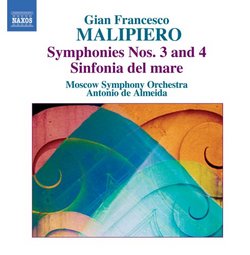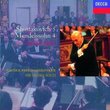| All Artists: Gian Francesco Malipiero, Antonio de Almeida, Moscow Symphony Orchestra Title: Gian Francesco Malipiero: Symphonies Nos. 3 & 4; Sinfonia del mare Members Wishing: 0 Total Copies: 0 Label: Naxos Original Release Date: 1/1/2008 Re-Release Date: 7/29/2008 Genre: Classical Styles: Historical Periods, Modern, 20th, & 21st Century, Symphonies Number of Discs: 1 SwapaCD Credits: 1 UPC: 747313087877 |
Search - Gian Francesco Malipiero, Antonio de Almeida, Moscow Symphony Orchestra :: Gian Francesco Malipiero: Symphonies Nos. 3 & 4; Sinfonia del mare
 | Gian Francesco Malipiero, Antonio de Almeida, Moscow Symphony Orchestra Gian Francesco Malipiero: Symphonies Nos. 3 & 4; Sinfonia del mare Genre: Classical |
Larger Image |
CD DetailsSimilarly Requested CDs |
CD ReviewsThe First in a Series of Budget Reissues of Almeida's Ground J Scott Morrison | Middlebury VT, USA | 10/10/2008 (4 out of 5 stars) "This Naxos release is, I believe, the first in a series of reissues of a complete set of Gian Francesco Malipiero's symphonies which originally appeared in the early 1990s on Naxos's full-price sister label, Marco Polo. Antonio de Almeida, who lamentably died in 1997, conducts the Moscow Symphony Orchestra. I could do no better than refer you to a fine review of the Marco Polo disc written by 'Discophage' Gian Francesco Malipiero: Symphonies Nos. 3 & 4; Sinfonia del mare before adding a few comments of my own. The one-movement 'Sinfonia del mare' was written in 1906 when Malipiero was in his early twenties. It has no special narrative program but the nature of the music seems to limn the awesome power of the sea and possibly lauds the long and illustrious history of Italian maritime exploration. The strong impressionist style reminds one of perhaps Dukas or Respighi. The Symphony No. 3 'delle campanie' ('of the bells') wasn't written until almost forty years after the 'Sinfonie del mare' and Malipiero indicated that it was inspired by the bells of St. Mark's which, he says, no longer rang for peace but to announce 'new torments, new suffering'-- the capitulation of Italy to the German nazis. In the usual four movements, the 24-minute symphony is in a starker, more dissonant tone then Malipiero's earlier music. But this is mitigated by Malipiero's extraordinarily evocative imitation of 'Venice all vibrating with bells'. Particularly effective is the funereal pealing of low bells in the second movement, the coruscating, glinting bell sounds from piano, harp and tuned percussion in the Scherzo, and the return of the anguished pealing of the second movement's bells toward the end of the finale. Symphony No. 4, 'in memoriam' (1946), is dedicated to the memory of the recently-deceased Natalie Koussevitsky. The symphony fittingly has two slow movements. The first of these is marked 'lento funebre' and is surely one of Malipiero's finest movements of all. There is a haunting English horn melody (also taken up by muted trumpets) that stubbornly sticks in one's mind. The Scherzo is inhabited with harsh quartal harmonies, creating a kind of protest or anguished cry. The finale, the second lento movement, is a set of variations based on a keening English horn, later bassoon, melody; it closes in a soft, distant, resigned atmosphere. This symphony is harder to assimilate than the Third, but on repeated listening becomes stronger and stronger in one's imagination. I have not heard the original Marco Polo release and cannot compare the sonics of the two releases. This Naxos release has a slightly distant ambience. The Moscow Symphony is adequate but not world-class. Almeida, who made a specialty of Malipiero's music, clearly understands how this music should go. Scott Morrison" Tough but rewarding music G.D. | Norway | 03/07/2010 (4 out of 5 stars) "The music of Gianfrancesco Malipiero has received a fair amount of recordings, but Malipiero was enormously prolific, and the record industry has barely scratched the surface of his output, in particular with respect to his dramatic works. Fortunately, Marco Polo made an important contribution to our view of the composer by recording his symphonies, which are now being reissued by Naxos, and luckily, the performances are generally pretty good. Of course, with an oeuvre as large as Malipiero's the quality of the music is inevitably going to be variable, and the three works here aren't consistently first rate, but the music is never less than good. Stylistically, Malipiero was heavily influenced by his study of the music of Monteverdi and Frescobaldi, and his style stands in stark contrast to the late-romanticism and verismo styles that immediately preceded him, mixing neo-baroque and neo-classical elements with influences from the music of Debussy and his contemporary Casella. Still, the impression is of a markedly original, if not stylistically very consistent voice. The Sinfonia del mare is an early work (1906), and is more of a symphonic poem than a symphony. The language is surprisingly impressionistic, appealingly atmospheric but in the end rather inconsequential and not particularly memorable. The third symphony dates from 1944-45, and is an anguished work written in response to the German invasion of Italy and inspired by the doom-laden tolling bells of the St. Mark's Cathedral. The dark tone of the work never lets much light through, especially not in the highlight of the work, the spiteful scherzo - even if there are touches of serene beauty and the work ends on what must be said to be an optimistic note. Overall, the work is most notable for its stirring, strange and disconcerting textures and sonorities, arranged in an interestingly effective formal structure. It is not an easy work, but one that rewards concentration and repeated listening, and I'd judge it to be the strongest work on the disc. The fourth symphony opens with an energetic but somewhat rough movement - the scoring is again striking, but I am not completely convinced that Malipiero quite achieves the effects I can imagine he set out to achieve. The lamenting slow movement is more convincing; tough and gritty but rewarding and relieved by a rather inconsequential scherzo and ending in a slightly aimless but effectively chilly set of variations (the apparent aimlessness might have been intentional, one suspects). Overall, these are rewarding, personal and original works, even though they don't give up their goods very easily. The Moscow Symphony Orchestra are pretty effective advocates of the music, but lacks a little bit in tonal finesse and sheen, although Almeida leads them with an unerring sense of vision and understanding. The sound is a little distant and dry, but not really objectionable; recommended." Great to have 'em back, and cheap Discophage | France | 01/01/2009 (5 out of 5 stars) "Oh, great, so Naxos has started to reissue Antonio de Almeida's complete traversal of Malipiero's wonderful symphonies, which Marco Polo had originally published in the mid-1990s, then discontinued. This disc, with symphonies 3, 4 and the early Sinfonia del Mare, could still be found at afordable prices on the marketplace, but some of the other instalments simply didn't show up anymore. After months of search I just found the one that was missing to my collection, with Symphonies 1 & 2 and the early Sinfonie del silenzio e de la morte.
Anyway, it is great to have them back a the cheap Naxos prices. Sinfonia del Mare is a derivative, big post-Romantic work (which doesn't mean it isn't enjoyable) but Symphonies 3 & 4 are highly original. Malipiero's 3th Symphony, "delle campane" (of the bells), was written in 1944-5 and commemorates the taking over of Italy by the Germans, on September 9, 1943, a day when "the bells of St. Mark's Cathedral [in Venice] did not ring for peace but to announce new torments". The bells are evoked in various ways in the four movements, sometimes very graphically, sometimes in a very stylized manner, but always with a highly original orchestral inventiveness. Elsewhere Malipiero explained that hearing the bells of Venice ringing had offset the despondent mood created by the German invasion, and indeed, based only on its ebullient and rambunctious first and third movement, the Symphony could be subtitled "the Joyous". The first starts with a strikingly original orchestral tutti dominated by over-excitedly twittering woodwinds - a superb evocation of pealing bells, and this is only one of the many felicities and fine touches of orchestration offered by the Symphony. As the 4th and 7th, the 3rd Symphony presents the formal originality of alternating fast-slow-fast and ending with another slow movement, and while the three preceding one were very compact, the finale is more extended, mostly mournful and funeral, until the music makes its way back to a triumphantly exuberant ending with bells pealing. This is a strikingly original and beautiful composition, and one of Malipiero's best. Though not on the same level, the 4th Symphony also has many fine moments. It was composed in 1949, on a commission from the Koussevitsky foundation, hence its inscription and dedication "to the memory of Natalie Koussevitsky". Again, and as befits its subtitles, it contains more quasi funeral marches in its two Lentos (second and fourth movement), the first of these being specifically called "funebre", and the finale starting in the same mood with a mournful theme announced by English horn, then subjected to a series of variations that make it go through various moods and colors. The third movement, a short scherzo, is also quite impressive: based upon a rhythmic cell reminiscent of Beethoven's 7th Symphony, it is agitated, dramatic, menacing, unruly. The first movement is more predictable, with its quasi-marches of neo-classical vigor. Interpretively, Almeida and his Moscow orchestra are not vastly inferior in the 4th Symphony (only competition available) to the Bostonians under Koussevitzky, in what is presumably the premiere of the work, back in 1948, a performance available on a bootleg AS disc to be treasured by diehard collectors . See my review of the original release for more detailed and argued comments: Gian Francesco Malipiero: Symphonies Nos. 3 & 4; Sinfonia del mare. For those preferring the original issue, there is another entry where it might be found for not so much more expensive than the Naxos reissue: Gian Francesco Malipiero: Symphonies Nos. 3 & 4; Sinfonia del mare." |









